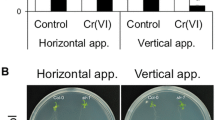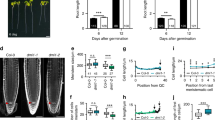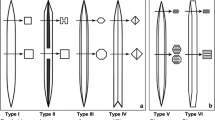Summary
Lemna minor root tips form raphide Ca oxalate crystals in both the root cap and root proper. An in vivo system was developed to examine raphide crystal bundle formation in the root of intact plants. By increasing the exogenous Ca concentration, crystal bundle formation could be induced. Entire new crystal bundles could be formed within 30 minutes of an inductive stimulus. The process was reversible with recently formed crystal bundles being dissolved over a period of about 3 hours. Older, previously existing bundles were more resistant to dissolution. The calmodulin antagonists, chlorpromazine and trifluoperazine (300 μM), prevented crystal formation and caused dissolution of some crystal bundles, even in the presence of exogenous Ca. When the antagonists were flushed out and replaced with fresh medium, crystals were formed in cells where dissolution had occurred under the influence of the antagonists. The Ca ionophore A 23187 (20 μM) caused slow dissolution of crystal bundles, even in the presence of exogenous Ca. A model describing the control of and physiological significance of Ca oxalate formation in plants is presented and discussed with respect to the results obtained in this study.
Similar content being viewed by others
Abbreviations
- Ca:
-
calcium
- DMSO:
-
dimethyl sulfoxide
References
Arnott HJ, Pautard FGE (1970) Calcification in plants. In: Schraer H (ed) Biological calcification. Appleton-Century Crofts, New York, pp 375–446
Assailly A (1954) Sur les rapports de l'oxalate de chaux et de l'amidon. Compt Rend Acad Sci D 238: 1092–1094
Borchert R (1985) Calcium-induced patterns of calcium-oxalate crystals in isolated leaflets ofGlditsia triacanthos L. andAlbizia julibrissin Durazz. Planta 165: 301–310
— (1986) Calcium acetate induces calcium uptake and formation of calcium-oxalate crystals in isolated leaflets ofGleditsia triacanthos L. Planta 168: 571–578
Calmes MJ (1969) Contribution a l'étude du métabolisme de l'acide oxalique chez la Vigna-vierge (Parthenocissus tricospidata Planchon). Compt Rend Acad Sci D 269: 704–707
Carles J (1970) Le répartition et l'évolution des cristaux d'oxalate de calcium dans les tissues de Vigne-vierge au cours d'un cycle de végétation. Bull Soc Bot Fr 117: 189–198
Piquemal M (1977) Variation saisonniére des cristaux d'oxalate de calcium des tissus de Vigne-vierge. Can J Bot 55: 2075–2078
Cody AM, Horner HT, Cody RD (1982) SEM study of the fine surface features of synthetic calcium oxalate monohydrate crystals. Scan Electron Microsc 1: 185–197
Foster AS (1956) Plant idioblasts: remarkable examples of cell specialization. Protoplasma 46: 184–193
Franceschi VR (1984) Developmental features of calcium oxalate crystal sand deposition inBeta vulgaris L. leaves. Protoplasma 120: 216–223
— (1987) Oxalic acid metabolism and calcium oxalate formation inLemna minor L. Plant Cell Environ 10: 397–406
—, Horner HT Jr (1979) Use ofPsychotria punctata callus in study of calcium oxalate crystal idioblast formation. Z Pflanzenphysiol 92: 61–75
— — (1980) Calcium oxalate crystals in plants. Bot Rev 46: 361–427
—, Schueren AM (1986) Incorporation of strontium into plant calcium oxalate crystals. Protoplasma 130: 199–205
Frank E (1972) The formation of crystal idioblasts inCanavalia ensiformis D.C. at different levels of calcium supply. Z Pflanzenphysiol 67: 350–358
Gallaher RN (1975) The occurrence of calcium in plant tissue as crystals of calcium oxalate. Comm Soil Sci Plant Anal 6: 315–330
Hepler PK, Wayne RO (1985) Calcium and plant development. Annu Rev Plant Physiol 36: 397–439
Hinchee MAW (1983) The quantitative distribution of trichosclerids and raphide crystal cells inMonstera deliciosa. Bot Gaz 144: 513–518
Horner HT Jr, Wagner BL (1980) The association of druse crystals with the developing stomium ofCapsicum annum(Solanaceae) anthers. Am J Bot 67: 1347–1360
—, Whitmoyer RE (1972) Raphide crystal cell development in leaves ofPsychotria punctata (Rubiaceae). J Cell Sci 11: 339–355
Kausch AP, Homer HT (1984) Differentiation of raphide crystal idioblasts in isolated root cultures ofYucca torreyi(Agavaceae). Can J Bot 62: 1474–1484
Kirkby EA, Pilbeam DJ (1984) Calcium as a plant nutrient. Plant Cell Environ 7: 397–405
Libert B, Franceschi VR (1987) Oxalate in crop plants. J Agricult Food Chem 35: 926–938
Marmé D (1985) The role of calcium in the cellular regulation of plant metabolism. Physiol Veg 23: 945–953
—, Dieter P (1983) Role of Ca2+ and calmodulin in plants. In: Cheung WY (ed) Calcium and cell function, vol 4. Academic Press, New York, pp 263–311
Niethammer A (1931) Mikroskopie und Mikrochemie einiger Kalkoxalatausscheidungen in der Pflanzenzelle. Planta Med 12: 53–59
Paupardin C (1964) Recherches préliminaires sur le comportement de l'oxalate de calcium dans des tissues végétaux culturesin vitro. Rev Cytol Biol Vég 27: 253–257
Scott FM (1941) Distribution of calcium oxalate crystals inRicinus communis in relation to tissue differentiation and presence of other ergastic substances. Bot Gaz 103: 225–246
Tilton VR, Horner HT Jr (1980) Calcium oxalate raphide crystals and crystalliferous idioblasts in the carpels ofOrnithogalum caudatum. Ann Bot 46: 533–539
Van Balen E, van de Gejn SC, Desmet GM (1980) Autoradiographic evidence for the incorporation of cadmium into calcium oxalate crystals. Z Pflanzenphysiol 97: 123–133
Zindler-Frank E (1975) On the formation of the pattern of crystal idioblasts inCanavalia ensiformis D.C. VII. Calcium and oxalate content of the leaves in dependence of calcium nutrition. Z Pflanzenphysiol 77: 80–85
Author information
Authors and Affiliations
Rights and permissions
About this article
Cite this article
Franceschi, V.R. Calcium oxalate formation is a rapid and reversible process inLemna minor L.. Protoplasma 148, 130–137 (1989). https://doi.org/10.1007/BF02079332
Received:
Accepted:
Issue Date:
DOI: https://doi.org/10.1007/BF02079332




